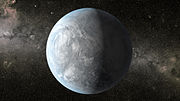Kepler-42, formerly known as KOI-961, is a red dwarf located in the constellation Cygnus and approximately 131 light years from the Sun. It has three...
12 KB (825 words) - 20:53, 29 October 2024
In astronomy, Kepler's laws of planetary motion, published by Johannes Kepler in 1609 (except the third law, and was fully published in 1619), describe...
60 KB (8,841 words) - 15:59, 14 November 2024
Kepler-37b is an exoplanet orbiting the star Kepler-37 in the constellation Lyra. As of February 2013[update], it is the smallest planet discovered around...
11 KB (887 words) - 18:23, 24 July 2024
2011. Kepler-10b has a mass of 3.72±0.42 Earth masses and a radius of 1.47 Earth radii. However, it lies extremely close to its star, Kepler-10, and...
15 KB (1,303 words) - 23:24, 8 October 2024
Kepler-62e (also known by its Kepler Object of Interest designation KOI-701.03) is a super-Earth exoplanet (extrasolar planet) discovered orbiting within...
15 KB (1,400 words) - 21:00, 6 October 2024
zone: Kepler-560b, Kepler-705b, Kepler-1229b, Kepler-1410b, Kepler-1455b, Kepler-1544 b, Kepler-1593b, Kepler-1606b, and Kepler-1638b. The Kepler team...
186 KB (16,796 words) - 19:33, 28 October 2024
Kepler-62 is a K-type main sequence star cooler and smaller than the Sun, located roughly 980 light-years (300 parsecs) from Earth in the constellation...
17 KB (1,612 words) - 03:25, 3 November 2024
In geometry, a Kepler–Poinsot polyhedron is any of four regular star polyhedra. They may be obtained by stellating the regular convex dodecahedron and...
31 KB (2,312 words) - 14:56, 29 July 2024
Kepler-90, also designated 2MASS J18574403+4918185, is a F-type star located about 2,790 light-years (855 pc) from Earth in the constellation of Draco...
19 KB (1,756 words) - 22:08, 6 November 2024
Johannes Kepler (/ˈkɛplər/; German: [joˈhanəs ˈkɛplɐ, -nɛs -] ; 27 December 1571 – 15 November 1630) was a German astronomer, mathematician, astrologer...
102 KB (12,606 words) - 08:45, 7 November 2024
Kepler-62f (also known by its Kepler Object of Interest designation KOI-701.04) is a super-Earth exoplanet orbiting within the habitable zone of the star...
24 KB (2,434 words) - 03:25, 11 September 2024
List of multiplanetary systems (redirect from Kepler-55)
with the most confirmed planets are the Sun (the Solar System's star) and Kepler-90, with 8 confirmed planets each, followed by TRAPPIST-1 with 7 planets...
264 KB (8,895 words) - 01:52, 10 November 2024
from the Kepler space telescope and confirmed in 2015. None of the planets orbit within the habitable zone. Kepler-445b, c, and d orbit Kepler-445 every...
6 KB (348 words) - 02:01, 27 September 2023
Kepler-42 c, previously KOI-961.02 then KOI-961 c, is an exoplanet orbiting Kepler-42, a star located about 131 light-years (40 pc) from the Solar System...
4 KB (320 words) - 23:26, 14 October 2023
Kepler-296e (also known by its Kepler Object of Interest designation KOI-1422.05) is a confirmed super-Earth exoplanet orbiting within the habitable zone...
9 KB (854 words) - 22:42, 10 February 2024
Kepler-186 is a main-sequence M1-type dwarf star, located 177.5 parsecs (579 light years) away in the constellation of Cygnus. The star is slightly cooler...
17 KB (1,540 words) - 03:22, 3 November 2024
In celestial mechanics, a Kepler orbit (or Keplerian orbit, named after the German astronomer Johannes Kepler) is the motion of one body relative to another...
42 KB (5,982 words) - 18:04, 20 December 2023
only 0.42 astronomical units away, and at its distance it completes an orbit once every 91.94 days. The planet orbits a G-type star named Kepler-90, its...
3 KB (210 words) - 07:35, 28 September 2023
Kepler-22 is a Sun-like star in the northern constellation of Cygnus, the swan, that is orbited by 1 planet found to be unequivocally within the star's...
10 KB (659 words) - 21:55, 24 August 2024
proven a false positive by NASA in 2015. Several other KOIs, like Kepler-577b and Kepler-1649b, were considered potentially habitable prior to confirmation...
59 KB (3,204 words) - 17:13, 14 November 2024
for him, wasn't it?". Kepler-42, a red dwarf in the constellation Cygnus that hosts the three smallest exoplanets found to date. 42 Isis, a large main-belt...
42 KB (4,625 words) - 16:43, 6 November 2024
Kepler-452 is a G-type main-sequence star located about 1,810 light-years away from Earth in the Cygnus constellation. Although similar in temperature...
13 KB (1,189 words) - 08:01, 9 May 2024
Kepler-1625b I is a possible moon of exoplanet Kepler-1625b, which may be the first exomoon ever discovered (pending confirmation), and was first indicated...
7 KB (602 words) - 20:19, 2 November 2024
This is a partial list of exoplanets discovered by the Kepler space telescope, running from star number 1 through 500, inclusive. All lists: 1–500 501–1000...
170 KB (2,916 words) - 06:55, 29 June 2024
Kepler-10, formerly known as KOI-72, is a Sun-like star in the constellation of Draco that lies 607 light-years (186 parsecs) from Earth. Kepler-10 was...
17 KB (1,525 words) - 23:30, 8 October 2024
two planets announced are designated Kepler-47b, and Kepler-47c, and the third, later discovery is Kepler-47d. Kepler-47 is the first circumbinary multi-planet...
22 KB (2,132 words) - 06:23, 22 December 2023
Kepler-51 is a Sun-like star that is about 500 million years old. It is orbited by four planets—Kepler-51b, c, d and e—first three of which are super-puffs...
11 KB (1,037 words) - 15:04, 4 November 2024
Kepler-160 is a main-sequence star approximately the width of our Galactic arm away in the constellation Lyra, first studied in detail by the Kepler Mission...
11 KB (969 words) - 04:25, 29 July 2024
Kepler-1625b is a super-Jupiter exoplanet orbiting the Sun-like star Kepler-1625 about 2,500 parsecs (8,200 light-years) away in the constellation of...
11 KB (1,060 words) - 20:18, 2 November 2024
PH2 (redirect from Kepler-86b)
with data from the Kepler space observatory. PH2 b was detected, along with 42 other planet candidates, in archival data from Kepler by the Planet Hunters...
11 KB (860 words) - 15:01, 18 July 2024



















